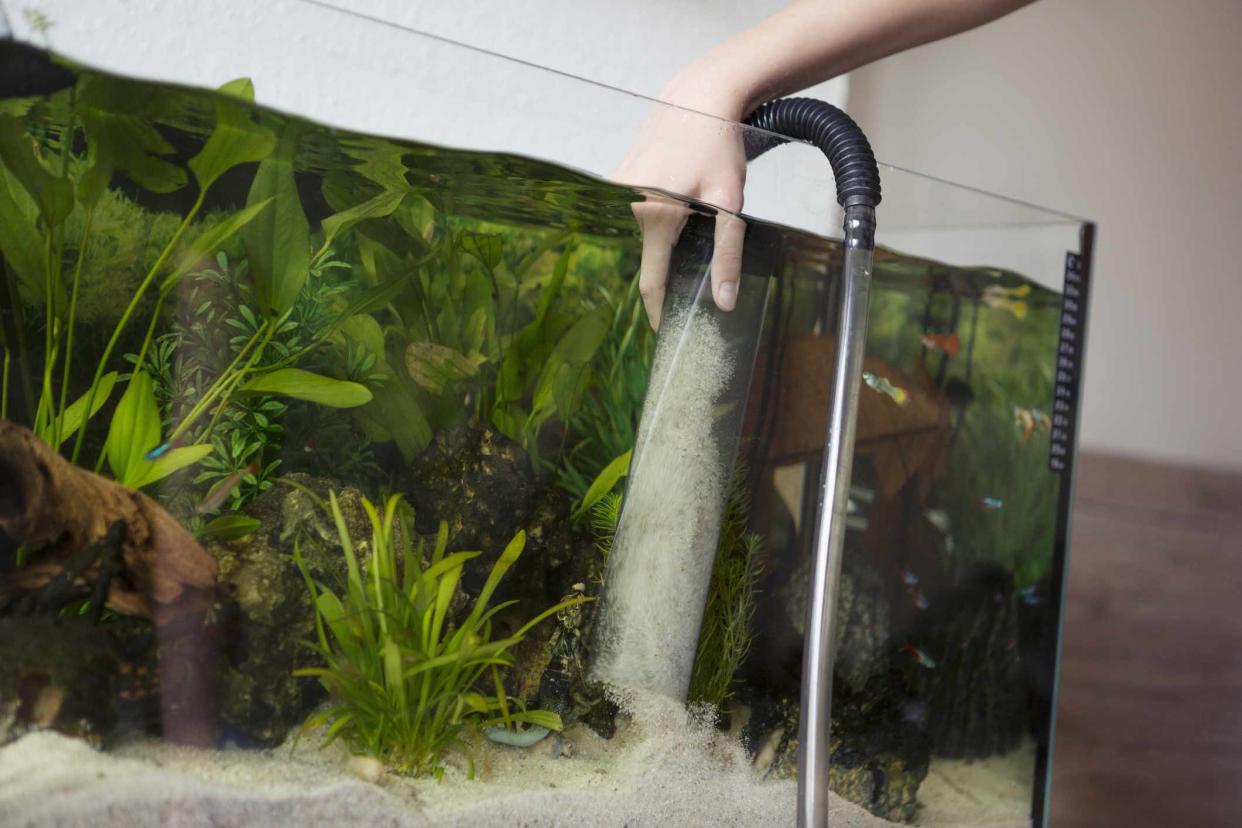How to Clean Aquarium Sand

No matter what substrate you have in your home aquarium, keeping it clean goes a long way to ensuring the health of your tank inhabitants. Sand substrate, from coarse to fine grain, can be a little bit trickier to deal with due to its lighter weight. Most of the discoloration on sand is troubling for human owners, wherein the fish and invertebrates do not mind very much. However, routine sand substrate cleaning is an essential chore that must be done on a regular basis.
Here's exactly how to clean aquarium sand and why it's so important for aquarium care.
The Importance of Clean Aquarium Sand
“Clean” aquarium sand may not look the way you expect. Although you may have added pristine white or tan sand at the beginning, you may notice that it turns brown or green very quickly. That’s okay—that is normal algae growth and indicates your ecosystem is healthy. Your fish and invertebrates may scoop up some of the sand, swishing it around in their mouths and then spitting it back out to clean. This can certainly help keep your substrate clean, but you’ll need to do a little bit more.
Prevent Compaction
The biggest issue with sandy substrate is that it can compact quickly. Compaction occurs as the sand settles without being disturbed for long periods. This may be due to your fish not being substrate cleaners, lack of invertebrates, or no access to the substrate due to overdecorating. As the sand compacts, it may lose contact with the water and the oxygen contained within it. This can lead to the formation of anaerobic bacteria, a type of bacteria that utilize sulfur instead of oxygen to survive.
If this pocket is ever disturbed and oxygen is reintroduced, it will kill off the bacteria and release hydrogen sulfide, which smells like rotting eggs. This compound can be very toxic to fish and invertebrates, such as corals. Routine cleaning of your substrate, not necessarily to bring back its color, but to provide adequate oxygenation, is a very important chore.
Necessary Tools and Materials for Cleaning Aquarium Sand
To perform a sand substrate cleaning, you will need a gravel siphon. Even though it is indicated for gravel, it works just fine for sand as well. Most gravel siphons are long, clear cylinders attached to a smaller diameter hose. For sand, you should choose a wider cylinder because this will provide less suction to the lighter sand.
Complete Aquarium Checklist for Beginners
Step-by-Step Guide to Cleaning Aquarium Sand
The easiest and most effective method of cleaning aquarium sand is by using a siphon. Here's how to most easily clean your aquarium sand:
Lots of debris can get trapped under rocks and décor, so remove as much as possible prior to beginning your cleaning.
Connect your siphon and put the end in a collection bucket.
Start the water flowing into the bucket through the siphon.
Stick the wide end of the hose into the sand and allow it to rise 1/3 to halfway up the siphon.
Pull the siphon up out of the sand and allow the sand to fall back to the bottom.
Move your siphon over one width-length and repeat, forming little mounds in a grid.
Keep an eye on your fill bucket and stop siphoning when the bucket gets full. Depending on your bucket and tank size, it might take a few rounds to get to all of the sand.
Use your waste water to rinse your filter media.
Add Cleaning Species to Your Tank
You may also consider letting your fish or invertebrates do the work for you. Many shrimp species will appreciate rooting around in the substrate for particles and some saltwater fish species, such as jawfish, like to move sand around to create underwater caves. However, even using these species, a routine sand cleaning at least once a month is recommended.
What Not To Do
Do not just stir up your sand every once in a while and expect your filter to do the work. Or even worse, just let your sand be. This is especially true if your sand is more than one-inch deep. Cleaning your sand and removing your décor may be a huge pain, but leaving it for months can have catastrophic consequences.
Tips for Maintaining a Clean Sand Bed in Your Aquarium
Cleaning and maintaining your aquarium sand may be one of the biggest maintenance chores, but it can go a long way in keeping your environment healthy for fish. These tips should help make the process smoother.
Do not have a substrate deeper than 1 inch unless you have substrate-dwelling fish or inverts.
Bring in some species that will help keep your substrate clean, such as shrimp, crabs, or other fish species.
Use your gravel siphon regularly. It is the easiest tool to keep your sand clean.
Remember, your sand should not always be pristinely white or tan. A little bit of brown, red, or green indicates a healthy system.

